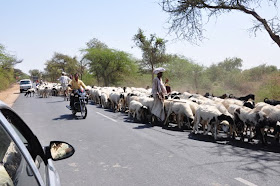Kutch is a region in the north of Gujarat, it is bordered to the north by Pakistan and the northeast by Rajasthan. The area is recognized for its flora, fauna and habitat for migrating birds including the salt marshes which form the 'Rann of Kutch'.

The area is also known for its exquisite handicrafts, especially its diverse styles of embroidery, which vary with the different tribal communities who live in the region.

The area is also known for its exquisite handicrafts, especially its diverse styles of embroidery, which vary with the different tribal communities who live in the region.

It is also a centre for terracotta, wood and metal crafts (jewellery, engraving and bell-making), tie-dyeing, block-printing and hand-painting.
Many of the groups and communities who inhabit the Kutch district have their origins in neighbouring regions including Rajasthan, Sindh and Afghanistan, arriving here through centuries of migration or forced displacement.  Many of the groups were once nomadic herds-people, seasonally moving around the desert regions across and around northern India.
Many of the groups were once nomadic herds-people, seasonally moving around the desert regions across and around northern India. Some struggle to maintain this traditional lifestyle as the region becomes more industrialized and traditional lands are lost to development; many are in communities where traditional life, dress and craft skills (a means of earning income) are quickly changing.
Some struggle to maintain this traditional lifestyle as the region becomes more industrialized and traditional lands are lost to development; many are in communities where traditional life, dress and craft skills (a means of earning income) are quickly changing.

 Many of the houses the residents now live in are made of concrete; as the cooler, earth and block houses are falling into disrepair.
Many of the houses the residents now live in are made of concrete; as the cooler, earth and block houses are falling into disrepair.
Both the mud and the concrete houses are often decorated.


 Metal wares, mostly water carriers, given as gifts at a couples wedding, line the shelves.
Metal wares, mostly water carriers, given as gifts at a couples wedding, line the shelves. The houses are colourfully decorated.
The houses are colourfully decorated. 
Some have cupboards and shelves embellished with painted clay and mirror work.



I liked the use of the lightbulbs.
 The men wear cotton smocks and many have earpieces; two discs of gold-work joined by a threaded tube, which pierces through the cup of the ear.
The men wear cotton smocks and many have earpieces; two discs of gold-work joined by a threaded tube, which pierces through the cup of the ear. The women wear coiled ear pieces, sometimes of gold or silver known as ‘Nagali’ earrings, they are said to be an abstract representation of a snake.
The women wear coiled ear pieces, sometimes of gold or silver known as ‘Nagali’ earrings, they are said to be an abstract representation of a snake.
 Adolescent Rabari girls are commonly tattooed at puberty, the patterns are seen as a type of jewellery which ‘they will take to the grave’. As well as for beautification, some patterns are associated with faith or good fortune, some are ‘caste marks’ representing a social and historic map of the individual; giving a sense of cultural identity in a traditionally nomadic society. The tattooing is often performed by elder women and takes place over several sessions within a given month.
The Kutch region is also known for its stunning neckpieces or torques called 'Vadlo' or 'Vaidlah' which are made using coiled wire techniques in silver.
Adolescent Rabari girls are commonly tattooed at puberty, the patterns are seen as a type of jewellery which ‘they will take to the grave’. As well as for beautification, some patterns are associated with faith or good fortune, some are ‘caste marks’ representing a social and historic map of the individual; giving a sense of cultural identity in a traditionally nomadic society. The tattooing is often performed by elder women and takes place over several sessions within a given month.
The Kutch region is also known for its stunning neckpieces or torques called 'Vadlo' or 'Vaidlah' which are made using coiled wire techniques in silver.

 This woman wears a nylon industrial sleeve as a bangle. The use of the object is an interesting adaptation and has a historic reference to the large hour-glass shaped ivory bangles called ‘Baloyun’ once worn by married Rabari women until widowhood or death.
This woman wears a nylon industrial sleeve as a bangle. The use of the object is an interesting adaptation and has a historic reference to the large hour-glass shaped ivory bangles called ‘Baloyun’ once worn by married Rabari women until widowhood or death.The nose jewellery this woman wears is similar in design to the earpieces of the Rabari men.

It seems almost every where you look there is all manner of methods of making beauty, making marks that enhance, individualise and identify.





















